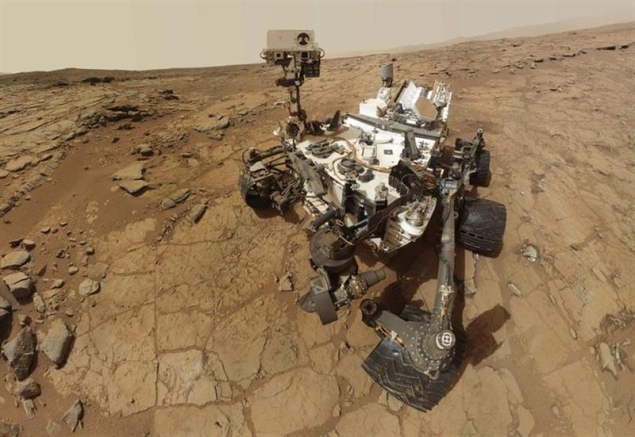- Home
- Others
- Others News
- NASA Mars rover ready to eat, analyze rock powder
NASA Mars rover ready to eat, analyze rock powder

The robotic geology station, which landed inside a giant impact basin on August 6 for a two-year mission, transferred about a tablespoon of rock powder from its drill into a scoop, pictures relayed by the rover Wednesday showed.
"We're all very happy to get this confirmation and relieved that the drilling was a complete success," Curiosity engineer Scott McCloskey of NASA's Jet Propulsion Laboratory in Pasadena, California, told reporters on a conference call.
On February 8, the rover used its powerful drill, the first instrument of its type to be sent to Mars, to bore inside a flat, veined piece of bedrock, which appears to contain minerals formed by flowing water.
The sample, retrieved from at least 2 inches (5 cm) beneath the surface of the rock, will be sieved and portions of it processed inside two onboard science instruments.
The gray powder is strikingly different than the ubiquitous red dust that covers the planet's surface, a result of oxidation from solar ultraviolet radiation.
"Having a rock-drilling capability on a rover is a significant advancement," said Louise Jandura, chief engineer for Curiosity's sample system.
"It allows us to go beyond the surface layer of the rock, unlocking a kind of time capsule of evidence about the state of Mars going back 3 or 4 billion years," Jandura told reporters.
The drill is the last of Curiosity's 10 science instruments to be tested since the rover landed inside Gale Crater, located near the planet's equator.
The site was selected because of a three-mile (5-km) high mound of what appears to be layered sediments rising from the crater's floor.
Rather than driving directly over to the mountain, scientists decided to explore an area in the opposite direction that showed intriguing signs of past water.
Water is believed to be a key ingredient for life.
"The rocks in this area have a really rich geologic history and they have the potential to give us information about multiple interactions of water and rock," said Curiosity scientist Joel Hurowitz, also with the Jet Propulsion Laboratory.
The fine-grained rocks are filled with veins and spherical deposits, including what appears to be calcium sulfate, a mineral which forms on Earth when water flows through fractures in rock. Mars is the planet in our solar system most like Earth.
"When you find exactly these sorts of conditions on Earth ... and everything still goes right, it's still an accident of fate to preserve organics," Curiosity's lead scientist John Grotzinger of the California Institute of Technology in Pasadena told Reuters.
"So we'll have to separate at some point the pursuit of what may have been a habitable environment from what may or may not be an environment that preserves organics," he said.
"Obviously we're interested in the organics but right now we're sort of on the pathway to hopefully characterizing this place as a habitable environment," Grotzinger said.
© Thomson Reuters 2013
Catch the latest from the Consumer Electronics Show on Gadgets 360, at our CES 2026 hub.
Related Stories
- Samsung Galaxy Unpacked 2025
- ChatGPT
- Redmi Note 14 Pro+
- iPhone 16
- Apple Vision Pro
- Oneplus 12
- OnePlus Nord CE 3 Lite 5G
- iPhone 13
- Xiaomi 14 Pro
- Oppo Find N3
- Tecno Spark Go (2023)
- Realme V30
- Best Phones Under 25000
- Samsung Galaxy S24 Series
- Cryptocurrency
- iQoo 12
- Samsung Galaxy S24 Ultra
- Giottus
- Samsung Galaxy Z Flip 5
- Apple 'Scary Fast'
- Housefull 5
- GoPro Hero 12 Black Review
- Invincible Season 2
- JioGlass
- HD Ready TV
- Laptop Under 50000
- Smartwatch Under 10000
- Latest Mobile Phones
- Compare Phones
- OPPO Reno 15 Pro Max
- Honor Win RT
- Honor Win
- Xiaomi 17 Ultra Leica Edition
- Xiaomi 17 Ultra
- Huawei Nova 15
- Huawei Nova 15 Pro
- Huawei Nova 15 Ultra
- Asus ProArt P16
- MacBook Pro 14-inch (M5, 2025)
- OPPO Pad Air 5
- Huawei MatePad 11.5 (2026)
- Xiaomi Watch 5
- Huawei Watch 10th Anniversary Edition
- Acerpure Nitro Z Series 100-inch QLED TV
- Samsung 43 Inch LED Ultra HD (4K) Smart TV (UA43UE81AFULXL)
- Asus ROG Ally
- Nintendo Switch Lite
- Haier 1.6 Ton 5 Star Inverter Split AC (HSU19G-MZAID5BN-INV)
- Haier 1.6 Ton 5 Star Inverter Split AC (HSU19G-MZAIM5BN-INV)

















